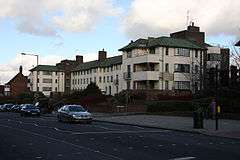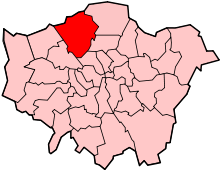Temple Fortune
Temple Fortune is a place in the London Borough of Barnet to the north of Golders Green. It is principally a shopping district used by residents of the Hampstead Garden Suburb. Between here and Golders Green, at Hoop Lane are two cemeteries – Golders Green Jewish Cemetery and Golders Green Crematorium. Religious buildings include the Catholic Church of St Edward the Confessor, St. Mary & Archangel Michael Coptic Orthodox Church, and North Western Reform Synagogue (also known as Alyth Shul).
| Temple Fortune | |
|---|---|
 The Pantiles, Temple Fortune | |
 Temple Fortune Location within Greater London | |
| London borough | |
| Ceremonial county | Greater London |
| Region | |
| Country | England |
| Sovereign state | United Kingdom |
| Post town | LONDON |
| Postcode district | NW11 |
| Dialling code | 020 |
| Police | Metropolitan |
| Fire | London |
| Ambulance | London |
| UK Parliament |
|
| London Assembly | |
History
'Temple' derives from the Knights Templar, a medieval Christian military order which held a sub-manor in the area, while 'Fortune' may come from foran tun, a settlement in front of the main one.[1] Here a lane from Finchley, called Ducksetters Lane (c.1475), intersected. It is likely that the settlement was originally the Bleccanham estate (c.900s). By the end of the 18th century Temple Fortune Farm was established on the northern side of Farm Close.
The building of the Finchley Road (c.1827), replaced Ducksetters Lane as a route to Finchley, and resulted in the development of a small hamlet. Hendon Park Row (c.1860s) is of this period, and consisted of around thirty small dwellings built by a George Stevens, which were, with two exceptions, demolished (c.1956). A small dame school and prayer house run by Anglican Deaconesses existed in the 1890s and 1900s, which developed to become St Barnabas (1915). Along the Finchley Road was a number of villas (c1830s), joined by the Royal Oak public house (c.1850s). By the end of the 19th century there were around 300 people living in the area, which included a laundry, a small hospital for children with skin diseases. The principal industry was brick making.
In 1895 a Jewish cemetery was established adjacent to Hoop Lane, with the first burial in 1897. Golders Green Crematorium opened in 1902 (although much of it was built after 1905). The significant moment in Temple Fortune's development into a suburban area occurred in 1907. The establishment of the Hampstead Garden Suburb brought major changes to the area east of the Finchley Road. Temple Fortune Farm was demolished, and along the front of the road, the building of Arcade, and Gateway House (c.1911) established the Hampstead Garden Suburbs retail district. Also significant in that year was the opening of Golders Green tube station. Although the area had been served by horse-drawn omnibuses (since at least the 1880s) and later motor buses (from 1907), it was the tram line of 1910, connecting Church End with Golders Green Station, which led to the development of the area west of the Finchley Road. A Carmelite Monastery was established in Bridge Lane in 1908.
St Edward the Confessor, a Roman Catholic church, was built in 1916.
The now demolished Orpheum Theatre (1930), was intended to rival the Hippodrome in Golders Green. It was for a long time a huge Odeon cinema, seating over 1,800 people, but a sheltered-accommodation building (Birnbeck Court) now stands on the site at 850, Finchley Road.
St Barnabas church was closed in 1994[2] and re-dedicated in 1996 as St. Mary & Archangel Michael Coptic Orthodox Church[3]; the Carmelite Monastery was acquired for residential development in 2007[4], to become Carmel Gate.
Geography
Recreation
The Temple Fortune Club is a private sports club established in 1922, offering bowls, squash and tennis. It is for members only and does not have 'pay and play' facilities in any section.
Temple Fortune Football Club was formed in December 1968 at Princes Park by a group of local youngsters who originally played in parks in the mid-1960s. The club joined the Maccabi (Southern) Football League in 1976 and were founder members of the Maccabi Masters Football League (veterans) in 1999. The club now plays its home games at the Roger Bannister Sports Centre in Pinner. In 2008 TFFC celebrated its 40th anniversary by holding a commemorative tournament at Princes Park.
References
- Hewlett, Jan; Yarham, Ian; Curson, David (1997). Nature Conservation in Barnet. London Ecology Unit. p. 7. ISBN 1 871045 27 4.
- https://discovery.nationalarchives.gov.uk/details/r/79dc7883-30f5-45b9-8d78-1a4224fdbfc8
- https://londonchurchbuildings.com/2017/04/29/st-mary-archangel-michael-cranbourne-gardens-temple-fortune-coptic/
- https://www.propertyweek.com/news/nuns-move-from-golders-green/3096265.article
